By Sandra Hutchinson
This blog post is my second about the trip to northern India that my husband and I took in January, 2017. My first post covered our nonstop round trip flights between Newark, NJ and Delhi on United Airline’s new Polaris class. (See my personalized tips at the bottom of this post for some quick Delhi travel ideas.)
Delhi, a region encompassing New Delhi, the capital city of India, is teeming, crowded and polluted. One of the most densely populated metropolitan areas in the world, figures vary on how many people live there. Over 25 million people are believed to live within the region, with many thousands of people entering Delhi every day from outlying regions and other parts of the world.
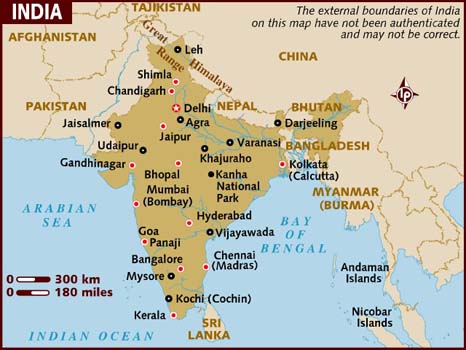
Most organized tours to northern India focus on what’s called the Golden Triangle — Delhi, Agra (home to the Taj Mahal), and Jaipur, southwest of Delhi in Rajasthan, India’s largest state.
Most Western tourists on a typical organized tour spend only two days or so in Delhi, enough time to only get slightly acclimated to the time zone (10 1/2 hours later than US Eastern Standard Time) and see a few major sites. We spent a full week in Delhi in January, and another day and a half there after returning to the city after visiting Agra and traveling for a week in Rajasthan. The reason? Our trip was focused on visiting our younger son, who is currently living in Delhi.
Be prepared for pollution
From the moment we left the international arrivals terminal at Indira Ghandi Airport on New Year’s Day, we struggled with the air pollution. Home to millions of cars, buses, trucks, motorized rickshaws and motor bikes, the vehicular exhaust combines with trash burning to fill the air with an acrid, particulate-laden smog. Just before our visit, in November and December, there had been an air pollution crisis in the city, with smoke from farmers burning crops to the west combining with vehicular smog, smoke and particles from the multi-day, extensive fireworks surrounding the Hindu holiday of Diwali (Festival of Lights), and winds and temperatures that exacerbated the unhealthy situation. Our son and his girlfriend were forced many times to stay indoors, and when they did go out, they wore masks with air filter mechanisms. For me, an environmental attorney who in the past represented New York State’s air pollution program, it was hard to take.
The pollution levels are not always this bad, but I do recommend doing some research before you go, to see what you will be up against. Consider buying face masks with filters before you depart from home.
Major historic monuments in Delhi
The sprawling metropolis of Delhi has a number of monuments that are on most tourists’ checklists. These include the impressive sandstone tower Qutub Minar, begun in 1193 to commemorate the Muslim defeat of Delhi’s last Hindu ruler. Standing 240 feet tall (73 meters), it is the tallest tower, or minaret, in India. It is surrounded by other ruins and structures from the same time period, including what is said to be the first mosque to be built in India. As with most monuments in India, there is a local price, for Indians, and a much higher entry fee for “foreigners.” Here, it was 30 rupees (about 45 cents) as compared to 500 rupees (about $7.50).
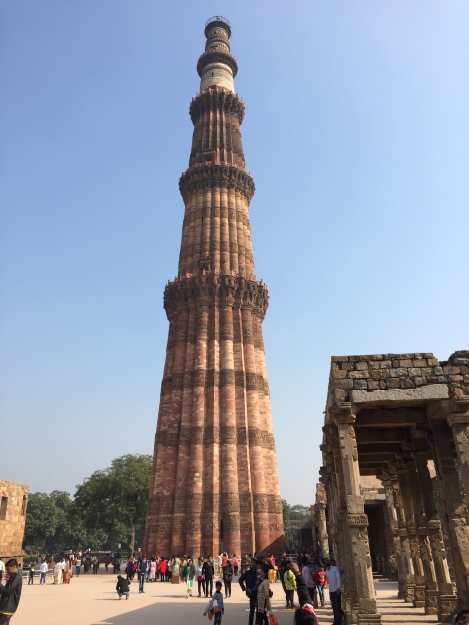
The impressive 13th century Qutub Minar in Delhi. (This was taken on one of the few blue-sky days we had while in Delhi.)
It was at the Qutub Minar that we noticed a group of Western, college-aged students being led by a man who appeared to be Indian, wearing a University of Virginia Cavaliers baseball cap. When my son, a recent graduate of the university, approached him, and asked whether he was affiliated with the school, we discovered that he is a professor at UVA, and he was leading a study program for students from the university’s McIntire School of Commerce. They were in the midst of a week in Delhi studying entrepreneurship, after which they were traveling to Dubai for another week. (We ended up being invited to a panel discussion and reception the group was hosting the following night, where we met a Delhi entrepreneur who had obtained his doctorate from UVA. He then invited us to be his guests at the historic Delhi Gymkhana Club, where we met an Indian journalist, which made for an unexpected experience and animated discussion. I digress, but the point is that you never know the interesting connections you will make when you step out of your comfort zone and strike up conversations with strangers. Alternatively, always wear something with your alma mater’s logo on it!)
Other significant heritage monuments in Delhi include Humayan’s Tomb, a striking example of Mughal architecture begun in 1526. It looks like a smaller, sandstone version of the marble Taj Mahal, which was commissioned in the 17th century. Like the Taj Mahal, Humayan’s Tomb is surrounded by gardens and symmetrical water channels.

Humayan’s Tomb in Delhi looks like an earlier, sandstone version of the white marble Taj Mahal.
In Delhi’s popular Lodi Gardens, there are a number of monuments and tombs from the Lodi and Sayyid periods, from the 15th and 16th centuries. There are some interesting carvings and mosaics within the structures. We found people playing cricket, picnicking, walking, and doing yoga in Lodi Gardens, which is a 90-acre park in the center of New Delhi.

Mohammed Shah’s Tomb in Lodi Gardens, built in 1444, is the earliest structure in the park.
Not to be missed is Jama Masjid, the most famous mosque in India. Built in the 1650s, the courtyard can hold up to 25,000 worshippers. It’s located in Old Delhi, adjacent to the must-visit market, Chandni Chowk. As with all mosques, you must remove your shoes before entering the holy space (remember to bring socks), and it is closed at times for prayers.
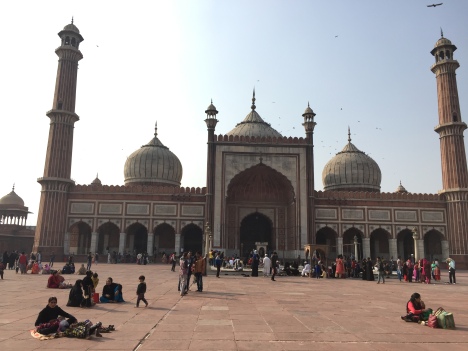
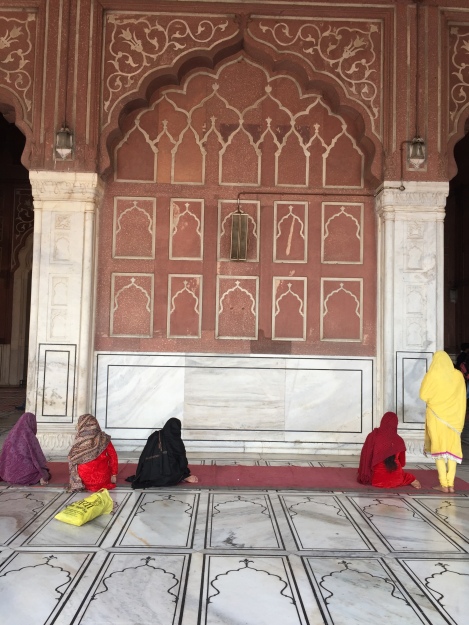
Women praying at Jama Masjid, the largest mosque in India.
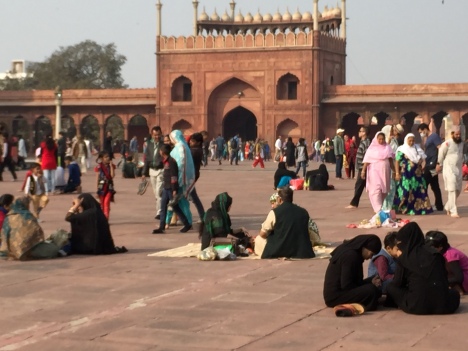
Families in the courtyard at Jama Masjid.
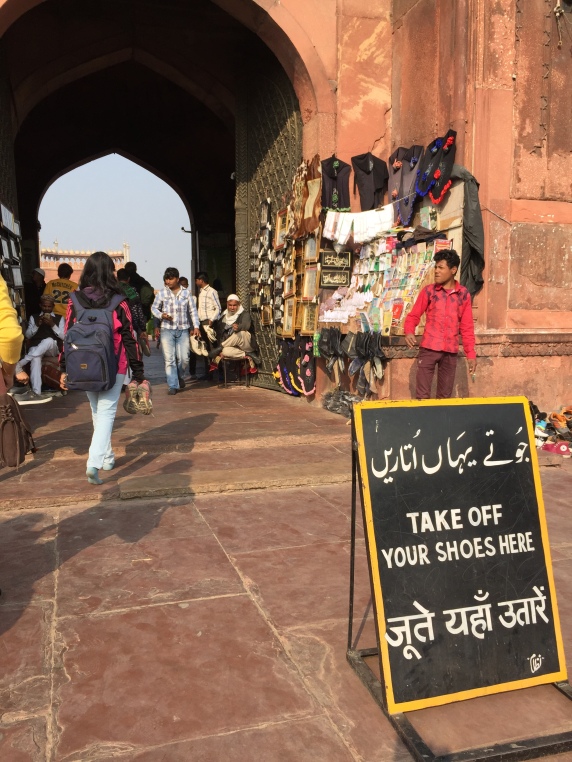
Adjacent to Jama Masjid is the bustling Chandni Chowk market of Old Delhi. I don’t think a visit to Delhi would be complete without venturing into this centuries-old, jam-packed market with labyrinthian lanes. It is intimidating at first because of the crowds (bustling would be a gross understatement) and the energy level. If you are on your own, and not with a tour group, you can negotiate with a bicycle rickshaw driver to take you through the market. Make sure to tell him you’d like to see the spice market! We were fortunate to run into a rickshaw driver who our son had used on a prior visit to the market (what were the chances??) and we arranged for him and his friend, another rickshaw driver, to bike us through the market.
Chandni Chowk is roughly divided into different sectors that focus on different types of products and wares. For example, you can find the streets where merchants sell shoes, textiles, household goods, auto parts, stationery and paper goods, produce and meats (complete with butchering out in the open). There’s a lot of “street food,” and people cooking on open fires, if you’re brave enough to try it. (We weren’t, on advice of our travel doctor.) The streets are absolutely packed with pedestrians, rickshaws (bicycle and motorized), motor bikes, dogs, even goats. It’s an unforgettable experience.

Grid lock! Street scene, Chandni Chowk.
After winding our way through the traffic and some of the main market streets, we left the rickshaws and walked through some spice shops, where we bought tandoori spice mixes and garam masala. But the highlight was being taken up a tucked-away stone staircase, up several stories, where we ended up on a rooftop looking down into the main street of the spice market. On each floor of the building, going up, we encountered many large burlap and cotton bags of spices, where the wholesalers bring them to divvy up for sale by merchants below in the stores. We sneezed and cough most of the way through, but the view from the roof was remarkable.

Bags of dried chilis in the spice wholesale area, Chandni Chowk market, Old Delhi.

Fantastic! View from top of building where spice wholesalers store and distribute products, looking down to main street of spice merchants. Chandni Chowk Market, Old Delhi. We could also watch monkeys on the rooftops across the street!

Display in nut, spice and tea shop.
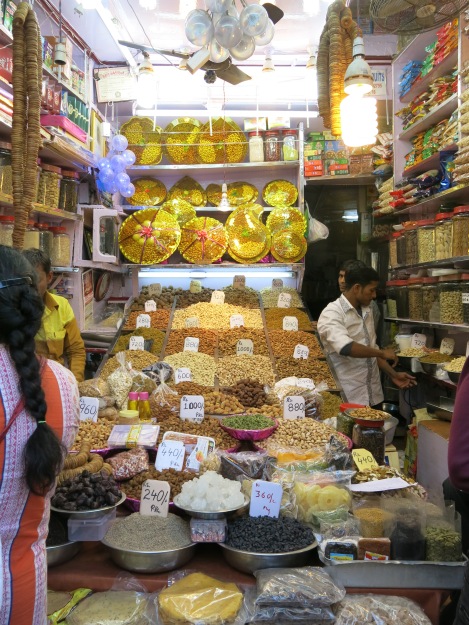
Nuts, spices, dried fruits in Chandni Chowk market.
Other sites on most tourists’ must-see list in Delhi include the Red Fort, which is a sprawling complex built in the 17th century as the main residence and political center of the Mughal emperors. Within the massive sandstone walls are buildings which reflect Islamic, Persian, Timurid and Hindu architectural traditions. These include a mosque, imperial apartments and audience halls, where the emperors would appear before the people. The fort encompasses about 150 acres within its walls (1.5 miles around). We felt the signage was somewhat lacking in its explanation of various buildings, so we were glad to have a Lonely Planet guidebook with us.
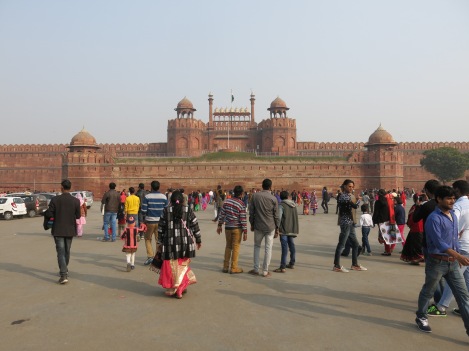
Exterior of Red Fort, Delhi

One of the Red Fort gates.

The massive sandstone walls of Red Fort

Mosque within Red Fort grounds

Marble imperial apartments featuring intricate inlaid designs.
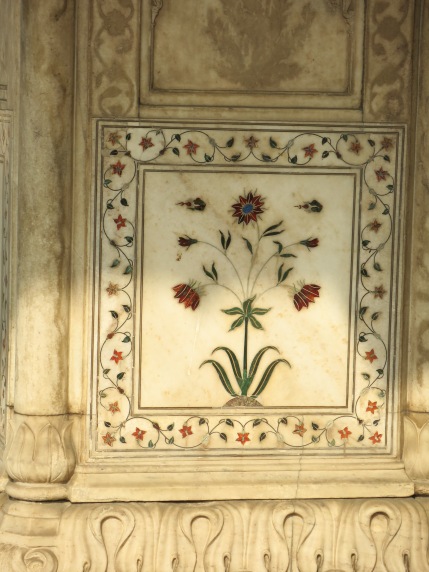
Closeup of some of the inlay work with semi-precious stones.
Sandra’s Tips on Delhi
There are many more monuments and museums to see in Delhi, but our best experiences were simply walking through different neighborhoods, particularly market areas, and interacting with people. Don’t be afraid to get into the thick of it — this is why you travel! You will marvel at the entrepreneurship of the Indian people, and the countless small businesses that exist. You’ll see men cooking street food in iron pots over open fires, and brewing masala chai on the sidewalk. You might see people who iron clothes outdoors for a few rupees, using large, bulky irons that have coals inside for heat. You might run across someone butchering a goat! Customers get a shave and haircut outside, on the sidewalk. There are people dying silk in pots on the street. Everyone seems to be selling something. The colors, the sounds, the smells, the energy of the culture is why India is often said to be “an assault on the senses.”
Because both my son and his girlfriend speak Hindi (and some Urdu, as well), we were able to have some particularly memorable interactions with people, like rickshaw drivers, who typically only have passing fluency in English. We were lucky to have been able to hear the translations by our son.
We tried a couple off the beaten path restaurants that our son and his girlfriend enjoy, but I couldn’t even begin to name them or explain where they are. We did have an excellent Indian meal at Karim’s, near Green Park. Many Indians use an app called Zomato to book restaurant reservations (similar to the Open Table app). I recommend using that to find restaurants and book tables.
We spent a few hours wandering through Hauz Khaz Village, in South Delhi, which is an interesting “hip” neighborhood with lots of young people, cafes, bars and restaurants. There’s a complex of early monuments and a mosque where people walk and hang out. We enjoyed tea and cake in a little French-themed bake shop, called Maison des Desserts.
Our hotel: the Leela Palace. We stayed for seven nights at the 5-star Leela Palace Hotel, near Delhi’s Diplomatic Enclave. Security was tight (metal detector, soldier with rifle standing guard, and wand body check of every person entering). The Leela was like our cocoon at night, where we could retreat from the chaos, noise, traffic and frenetic energy level of the city. I booked directly on the hotel’s website, and found what I felt was a decent rate (about US $232 a night plus substantial tax of about another $62) for a large, beautifully appointed room with king bed and enormous marble bathroom (including a deep soaking tub). Our rate included free wifi, two pieces of laundry a day, one way airport transfer (we were picked up at the airport in a high-end BMW) and an astounding breakfast buffet each morning at the hotel’s Qube Restaurant.

Rooftop infinity pool at the Leela Palace. The haze is smog.
The hotel has a rooftop infinity pool, although we never used it, and an on-premises spa, where my son’s girlfriend and I enjoyed some reflexology and an ayurvedic massage. It was sheer bliss, complete with ginger tea in the relaxation room. Other features we enjoyed were an outdoors hardscape patio with fire features, and a cozy, intimate library where we enjoyed late-night cocktails and snacks.

Leela Palace lobby from second level

Delicious breakfast offerings at the Leela. Combination of Western and Indian foods. The coffee in the metal tumbler is South Indian, a blend of dark roast and boiled milk. Delicious.

Inside the Qube, the steel and glass restaurant at the Leela Palace.

Exterior view of the Qube, showing some of the grounds at the Leela Palace Hotel.
Be prepared to bargain. Indians bargain for everything. And I mean everything. Even when they tell you here is no bargaining, you can bargain. There’s lots of information in guidebooks and on the Internet about how to approach bargaining. Read it before you go.
If you’re intimidated by bargaining at shops on the street for Indian handcrafts or products, consider visiting the Dilli Haat, a government-sponsored bazaar that provides rotating booth space for craftspeople from across India. I understood that each vendor is there for several weeks at a time. This can be a more comfortable browsing and purchasing environment than some of the shops in the large market areas. There are also food vendors. There is a small admission fee. We also stopped at Central Cottage Emporium, near Connaught Place, where we found some nice silk Indian garments, paper mache boxes and textiles. Whereas the shopping at Dilli Haat is like an outdoors market, the Central Cottage Emporium is inside a large building and there is no entrance fee.
Transportation. Delhi has an extensive Uber network. Set up the app on your phone and use it (assuming you have set up your phone to have service in India). Our son told us all Ubers in Delhi are actually licensed taxi drivers. Also, motorized rickshaws are everywhere. It’s a great experience tooling around in one of these vehicles, most of which are powered now by compressed natural gas. Don’t be afraid to bargain with the driver for the price and always arrange the price before you set out. Most guidebooks do not recommend authorizing the driver to use the meter, but tell you to agree on a price first based on your destination.

Auto rickshaw in Delhi
We did ride the Delhi metro, which is clean and efficient. The front car of each train is exclusively for women. We traveled mid-day, getting on at the packed metro station near Chandni Chowk market, and I was fearful that the cars would be over crowded. Fortunately the women’s car was fairly open, and my husband and son were in the next car, standing where the cars adjoined, so we wouldn’t lose track of each other.
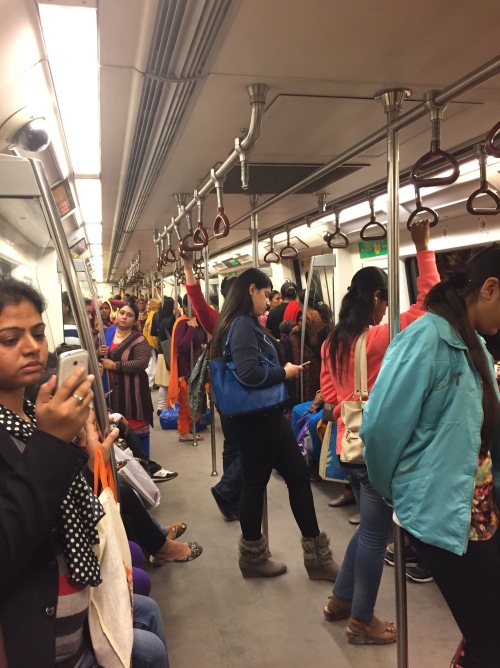
Women’s car on Delhi metro train.
We stopped into the Imperial Hotel, near Connaught Place, and had a drink in the famous 1911 Bar, with its oblong mahogany bar and beautiful handprinted wallpaper murals. The Imperial dates from the 1930s and incorporates old colonial and Art Deco styles. It was at the Imperial Hotel that Gandhi helped negotiate the 1947 partitioning of India.
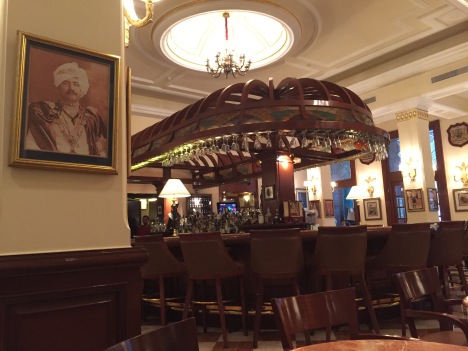

Close up of a scene on wallpaper panel. I’m guessing it’s a Zuber?
Security, hygiene. Be alert for pickpockets, particularly in crowded places like Chandni Chowk market. Men should not leave their valuables (cell phones, wallets) in pockets that are accessible or in backpacks whose pockets can be easily unzipped. I wore a “sling” bag/pocketbook that I could easily swing around to be on my front when I wanted to be extra cautious.
Only drink bottled water, and check to make sure the cap is sealed. It is not uncommon for people to sell water in bottles that have been refilled with tap water. Bring hand sanitizer with you, and paper tissues for use in public restrooms. Toilet tissue is frequently lacking in public facilities and the hand washing situation can be challenging.
Consider taking probiotics, beginning before you depart for India. We took a number of strains and believe it helped us avoid gastrointestinal problems. I also recommend finding a good travel doctor before you go and following his or her advice about vaccinations and prophylactic medicines (for example, malaria protection).
Be prepared to have your heart broken. You will see people in great need, begging, including many disabled people. There are young children begging, and mothers carrying babies, begging. You will see countless stray dogs, some of whom are limping and injured. You will see people living in highway medians. Immediately after we arrived late at night in Delhi, before we saw any people begging, we noticed many stray dogs trying to cross the roads as we headed to our hotel. Our son said “You have to prioritize which dog is going to ruin your day.”
Bring paper currency from home. We were in India shortly after the country-wide demonetization in November, 2016 that invalidated all 500 and 1000 rupee banknotes (approximately US $7.50 and $15). It remained a challenge to obtain cash from ATMs, which in the best of times, don’t always work well in India. There were days when we simply gave up trying to get rupees out of ATMs, and ended up exchanging US dollars at our hotel, and there were always strict limits on how many rupees we could obtain in a day. Visa and MasterCard are widely accepted in businesses, although sometimes shops share a credit card machine. Several times when I purchased something, the proprietor borrowed his neighbor’s processing machine. Try to use a card that doesn’t impose an international transaction fee (sometimes 3% of your purchase).
Next stop: The Taj Mahal and Agra Fort! Coming soon!

This is great. Fabulous photos! I love India.
LikeLike
Thanks for your comment. It is an eye-opening experience, for sure. We learned so much. Hoping to return, to see another part of this complex country.
LikeLike
Great review and love the photographs. Nicely done.
LikeLike
Thanks so much, Karen. There’s much more to tell and I’m working on additional posts.
LikeLike
Great post! Wonderful photos!! What a trip!!!
LikeLike
Thanks Gordon! I appreciate your positive comments! Look for more to come!
LikeLike
I love how you’ve described India. Great post!
LikeLike
Thank you for your comment! It was the trip of a lifetime. I’m working on another post on Rajasthan. Stay tuned!
LikeLiked by 1 person
Sure, looking forward
LikeLike
Wow. Another beautiful write up about your trip. Nicely done. Travel agents should have this.
LikeLike
Thanks for the great vote of confidence Karen! I really appreciate your reading my posts. Maybe you’ll get to India yourself!
LikeLike